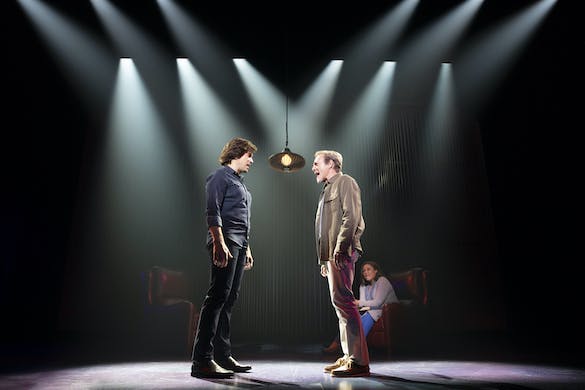Neil Diamond on Broadway: Sequins, Kitsch, and, Above All, Talent
While ‘A Beautiful Noise: The Neil Diamond Musical’ has its cringeworthy moments, as can be expected with this sub-genre, the music and the performances win the day.

Any honest musician will tell you there are few things more difficult than writing a perfect little pop song. Neil Diamond has written more than a couple — as well as fare that can be both meatier and more syrupy, with all the unapologetic bombast and perhaps less intentional kitsch of the sequined outfits he sported while performing during his ’70s and ’80s heyday.
The range of this musical palette, and the sequins, are on full display in “A Beautiful Noise: The Neil Diamond Musical.” So are the platitudes that invariably fuel those behind-the-music outings that tell us the stories of artists’ lives. In this case, that means following a humble, lonely boy from Brooklyn’s Flatbush who never envisioned being a star — or so he tells us, repeatedly — but somehow wound up “bigger than Elvis,” as one character hyperbolically puts it.
After speaking with Mr. Diamond extensively, librettist Anthony McCarten, an accomplished screenwriter whose credits include “The Theory of Everything” and “Bohemian Rhapsody,” decided to use the singer’s experience with psychoanalysis as a conceit. We meet Mr. Diamond — who retired from touring several years ago, after being diagnosed with Parkinson’s disease — as an older man, infused with vinegar and weariness by the redoubtable Mark Jacoby.
The younger Neil is embodied, most flatteringly, by the tall, dark, and handsome Broadway star Will Swenson, in flashbacks that chart Mr. Diamond’s path from crafting hits for other acts — he did so at the fabled Brill Building, where he met noted tunesmiths such as Ellie Greenwich and Bert Berns, both represented here — to enjoying his own superstardom.
The older Neil reluctantly digs into his past when prodded by his therapist, played by an elegant Linda Powell, who gamely delivers lines such as, “When did you first feel alone?” and “So there’s a high price to being the king.” We learn about his two failed marriages, his inadvertent dalliance with the mob, and his yearning, isolated childhood.
It’s pretty standard tortured-artist stuff, and yet “A Beautiful Noise” manages to fly on the strength of the collective talent behind it, not least of all Mr. Diamond’s. Notably, the team includes another prominent musician of his vintage: Bob Gaudio, a member and key creative force of The Four Seasons, whose own work was featured in one of the most popular and entertaining jukebox musicals to date, “Jersey Boys.”
In addition to serving as a lead producer of “A Beautiful Noise,” Mr. Gaudio helped design orchestrations (with Sonny Palladino and Brian Usifer) that capture the driving melodicism and theatricality of Mr. Diamond’s songs, from buoyant charmers like “Cracklin’ Rosie” and the Monkees single “I’m a Believer” to more contemplative numbers such as “Solitary Man” and “I Am … I Said.”
Mr. Swenson adjusts his resonant baritone to affect Mr. Diamond’s distinctive rasp and exaggerated vowel sounds — sometimes overdoing it on both, but summoning all his subject’s slick charisma, and then some. As Mr. Diamond’s second wife, Marcia Murphey, Robyn Hurder packs even more adrenaline into her singing and dancing, at one point turning the mid-tempo chestnut “Forever in Blue Jeans” into a vamp worthy of Roxie Hart.
Director Michael Mayer has recruited a diverse assortment of energetic performers to back up these principals. Clad in Emilio Sosa’s groovy, glittering, candy-colored costumes, they serve up harmonies that sound just as scrumptious while stretching and leaping through Steven Hoggett’s sinuous choreography.
As is always the case with such efforts, some familiar songs are inserted with painfully obvious setups. It’s hard not to cringe when Neil and Marcia, recognizing that their marriage is doomed, segue into the sappy duet, “You Don’t Bring Me Flowers.” On the other hand, while you can see “Sweet Caroline” coming from a mile away, it still lifts your heart instantly, an impeccably structured burst of pure joy.
Upon leaving the theater, in fact, I immediately popped out my headphones and blasted the latter Neil Diamond recording on iTunes. I suppose there’s no better testament to the success of a show — at least one of this sub-genre.

